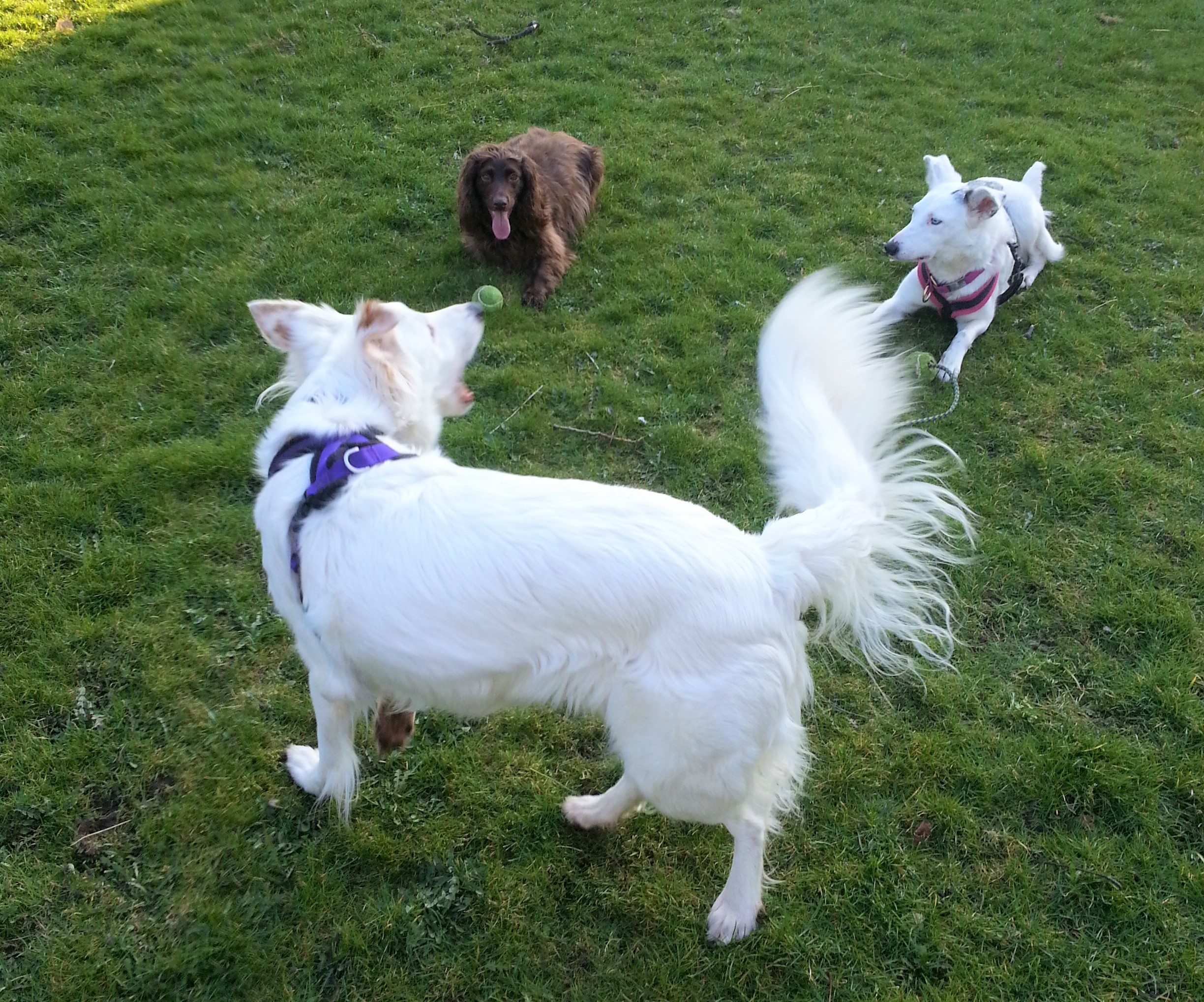Barks Blog
Why Do Deaf Dogs Bark?
By Morag Heirs

Barking is a form of communication for all dogs so it is important that we spend some time thinking about why our dogs might be barking. Are they anxious, over-excited, upset, fearful, thrilled, frustrated? Something else?
Avoid concentrating on stopping the barking (particularly through the use of ‘aversives,’ e.g. telling off, harsh signals, water spray or air sprays, exclusion from the room or crating on a regular basis) as this gets in the way of understanding why the barking is happening.
Without understanding why our dog is barking, we run the risk of suppressing anxiety, for example, which will inevitably resurface in other ways.
Why the Barking?
Anecdotally, we can see from the Deaf Dog Network Facebook discussion group that many new deaf dog owners are worried about barking. We are regularly asked if deaf dogs bark and if their barks sound different from hearing dogs. As a deaf dog owner I can reassure you that deaf dogs most certainly do bark, and my deaf dogs bark more than any of my hearing dogs.
A recent research paper indicates that, when surveyed, owners of hearing- or vision- impaired dogs reported more excessive barking than did owners of dogs who were not impaired (Farmer-Dougan et al., 2014). The tone of the bark can often sound different in hearing-impaired dogs (presumably due to lack of exposure to other dogs barking) and the vocalizations themselves can often include interesting variations, howls and squeaks.
Attention-Seeking Behavior
Some hearing-impaired dogs clearly recognize that barking can trigger a reliable response in either human or canine companions and so, just like a hearing dog, they may use barking as an attention-seeking behavior.
I know of one almost completely deaf and partially-sighted dog who will stand at the top of a large echoing hallway to bark when she wants to play or just seems bored.
Distress Signal
Just as in our normal hearing/vision dogs, barking can also signal distress. These dogs may struggle more with separation-related anxiety, in part due to the often disrupted early months of their lives, but also because the deaf dog cannot hear that you are nearby.
The visually-impaired dog may be able to hear you in the house but not physically locate you. We often see a degree of panic and the need to check where the family members are in the early days of bringing a deaf or visually- impaired dog into a new home.
Checking In
Using Bronte (pictured, above) as an example, she will frequently wake from a deep sleep, move purposefully over to where her human family is sitting and nose touch or sniff them before returning to her bed and going back to sleep. For all intents and purposes, this appears to be an essential check that the humans are still where they should be.
Separating out types of barks is tricky even in normal hearing/vision dogs. An interesting study that counted the frequency of barks (rather than recorded tonal variations) failed to find different patterns which would allow for differentiation between boredom and separation distress.
Thus, the fact that hearing-impaired dogs may bark differently is perhaps less of a barrier to interpretation that we first thought.
Volume of Barking
The volume of barking, especially in hearing impaired dogs, can be very loud. We can hypothesize that this is due to the lack of auditory feedback and, where the animal is also visually impaired, the barker may not be able to see if the desired response is occurring.
With completely deaf-blind dogs, barking is a frequently used communication strategy and separating out boredom, hunger, distress and frustration is always hard. Generally the caregiver simply has to check that all of the animal’s needs are being met and hope that this reduces the barking.
Frustrated Barking
Prevention is always better than cure. It will depend very much on the individual dog as to whether it is acceptable to allow a small amount of frustrated barking to work itself out.
Our observations suggest that the more sensory impairments a dog has, the more important it is to provide a predictable environment including meal times. When these dogs are “left to bark it out,” it often results in increased distress and even self-harming behaviors such as spinning and tail-grabbing.
Techniques to Interrupt Barking
If the deaf dog has a solid and positive association with being tapped as an attention request, you can use this. It is particularly helpful if the dog is getting over-excited with a visitor or another dog, to tap the dog on the side to ask him to reorient to you, reward and then make sure you have a plan of what to do next (e.g. provide a chew, ask for a settle).
If you have already taught the dog to recognize the feeling of a treat thrown to touch her shoulder (so the dog then looks down for the food), you can also use this as a way to interrupt the barking from a distance. While being aware of potential resource guarding issues, this can work well as a way to interrupt overly enthusiastic barking or chasing in dog-to-dog play.
Finally, with some deaf or vision-impaired dogs, interrupting the excited barking very early on with a simple tap + food reward and then using gentle restraining pressure can be a great way to help the dog relax and settle. As always, this is not a technique to use with a touch-sensitive dog, so be cautious in trying it out. We are definitely not pinning the dog nor forcibly restraining him.
A Cautionary Note
If the deaf or vision-impaired dog is barking when left alone, or when he thinks he has been left alone, this will need careful investigation and support.
Separation-related anxiety/distress can be a serious problem and is best tackled by a qualified professional who can create a tailored plan for the individual dog. We often provide individualized hearing/vision-impaired dog advice to other behavior counselors working with these cases, and would be more than happy to hear from any members in a similar situation.
References
Farmer-Dougan, V., Quick, A., Harper, K., Schmidt, K., & Campbell, D. (2014). Behavior of hearing or vision impaired and normal hearing and vision dogs (Canis lupus familiaris): Not the same but not that different. Journal of Veterinary Behavior 9 (6) 316–323
Raglus, T., De Groef, B., & Marston, L. (2015). Can bark counter collars and owner surveys help identify factors that related to nuisance barking? A pilot study. Journal of Veterinary Behavior 10 204-209
Resources
This article was first published in BARKS from the Guild, November 2015, pp.34-35.
Morag Heirs PhD MSc MA(SocSci)(Hons) PGCAP human and canine remedial massage therapist, is a companion animal behavior counselor who runs Well Connected Canine in York, UK. She works with deaf and blind dogs professionally, provides training and support for the Deaf Dog Network and is the behaviorist for Sheffield Animal Centre (RSPCA) and York & District RSPCA branches in the UK.

